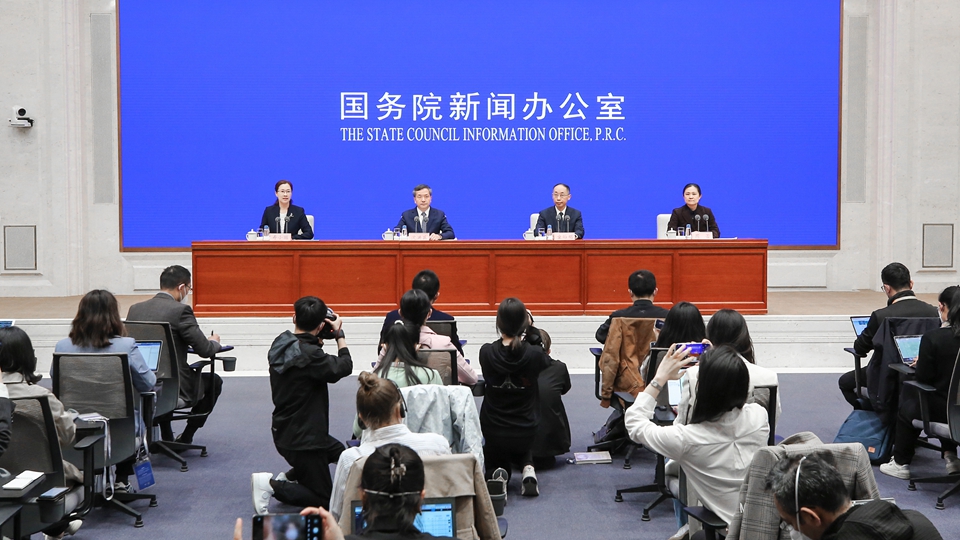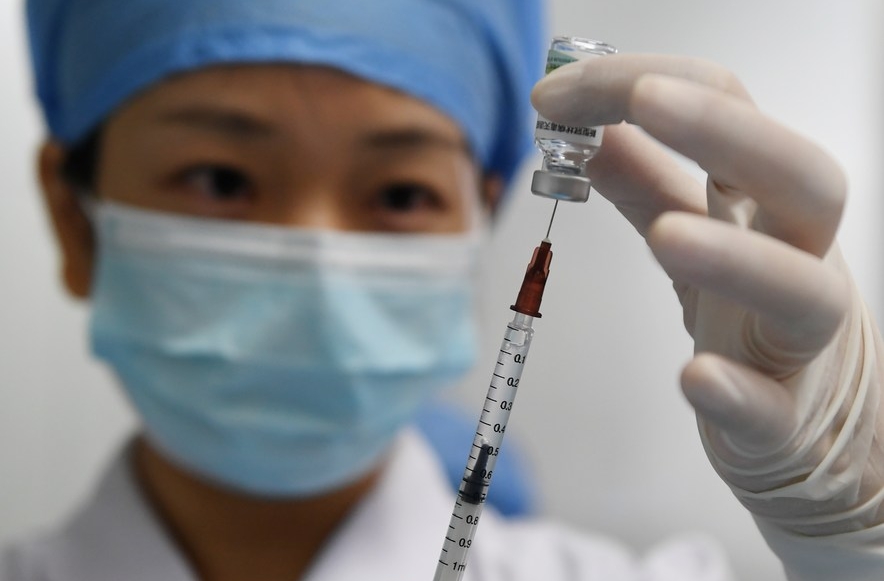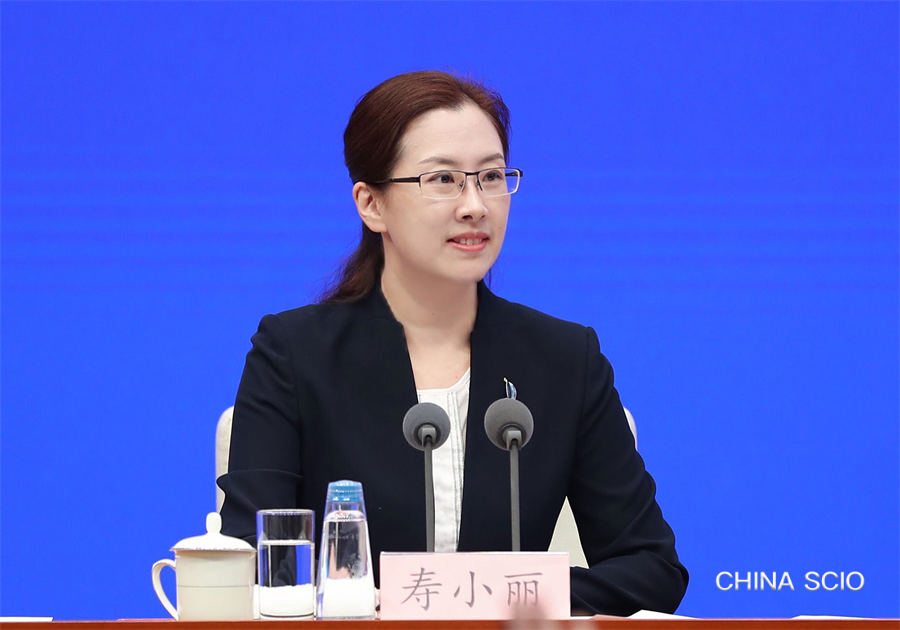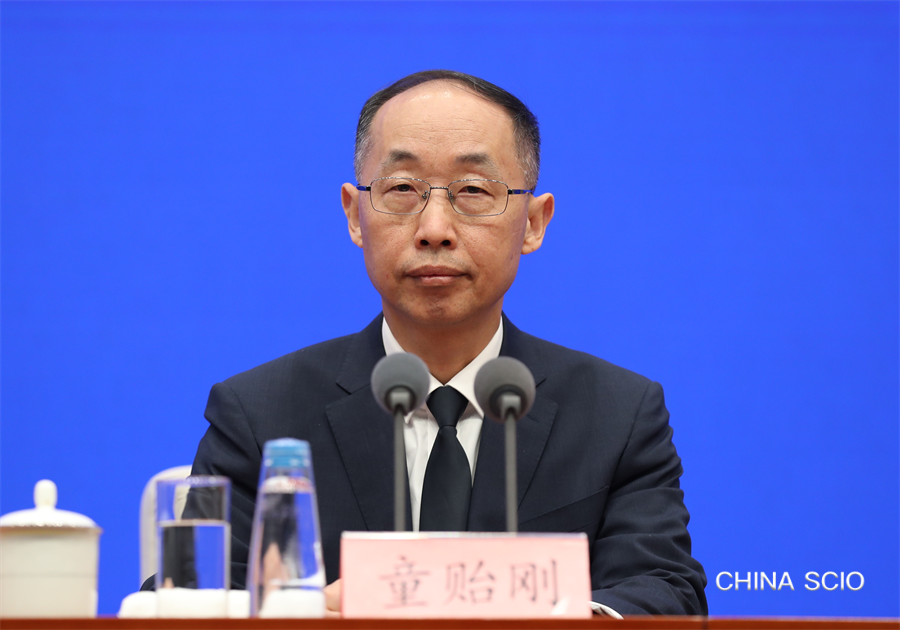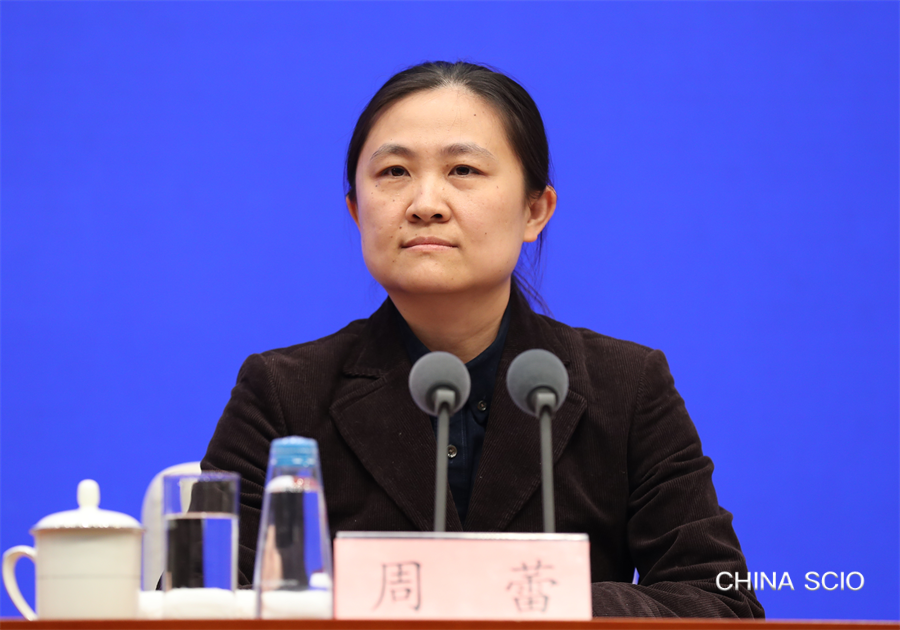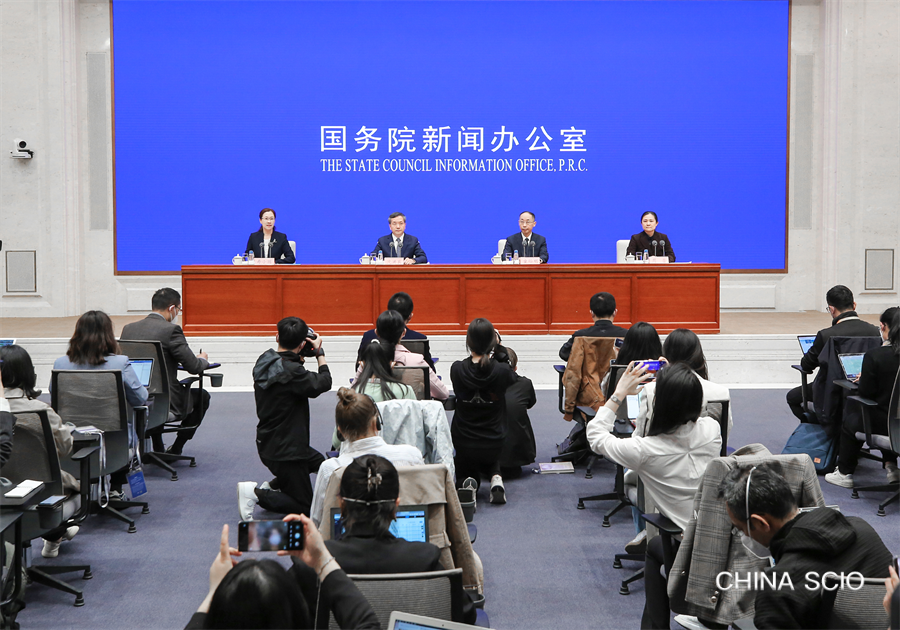.
Read in Chinese
Speakers:
Mr. Shen Hongbing, deputy director of the National Disease Prevention and Control Administration and director of the Chinese Center for Disease Control and Prevention (China CDC)
Mr. Tong Yigang, professor and dean of the College of Life Science and Technology at Beijing University of Chemical Technology
Ms. Zhou Lei, researcher at the China CDC
Chairperson:
Ms. Shou Xiaoli, deputy director general of the Press Bureau of the State Council Information Office (SCIO) and spokesperson of the SCIO
Date:
April 8, 2023
Shou Xiaoli:
Ladies and gentlemen, good afternoon. Welcome to this press conference held by the State Council Information Office (SCIO). Today, we have invited Mr. Shen Hongbing, deputy director of the National Disease Prevention and Control Administration and director of the Chinese Center for Disease Control and Prevention (China CDC), to brief you on China's study of the origins of SARS-CoV-2, and to take your questions. Also joining us today are Mr. Tong Yigang, a professor and dean of the College of Life Science and Technology at Beijing University of Chemical Technology; and Ms. Zhou Lei, a researcher at the China CDC.
Now, I'll give the floor to Mr. Shen for a brief introduction.
Shen Hongbing:
Friends from the media, good afternoon. It has been over three years since the outbreak of COVID-19 at the end of 2019. During this period, we have continually made efforts on related origin tracing. The study of the origins of SARS-CoV-2 is a highly specialized issue. The Chinese government and scientists have always upheld a science-based approach and hoped to clarify the origins of the virus. The matter is of crucial significance to preventing similar pandemics from happening again.
Now, I'll brief you on our origin tracing during the past three years from two aspects.
First, since the outbreak of COVID-19, China, as a major country committed to being open, has always upheld a science-based approach on the scientific issue of tracing virus origins. We have been actively communicating and cooperating with the World Health Organization (WHO). In response to the resolution adopted by the 73rd World Health Assembly, we took the lead in inviting the WHO to send international experts twice to conduct joint studies on the origins of SARS-CoV-2 in China. Under the principle of jointly formulating work plans, carrying out analysis and research, writing reports and publishing study results, the first phase of the joint origin tracing studies was accomplished in Wuhan. The report, titled "WHO -convened Global Study of Origins of SARS-CoV-2: China Part," or the "Joint WHO-China Study, " has been fully recognized by participating experts both at home and abroad as well as the WHO.
Throughout the first phase of the joint studies, China provided all the origin-tracing-related information that it had at the time to the joint team of experts and concealed no cases, samples, or test and analysis results. Recently, some officials and experts from the WHO willfully made comments and recklessly rejected the previous results. This totally violates scientific principles, rudely offends and disrespects the scientists around the world that participated in the previous origin tracing, and politicizes the origin tracing efforts. This cannot be tolerated by China's scientific community, nor can this be accepted by its global counterparts.
Second, based on the huge amount of human, material and financial resources invested in the first phase of the joint studies, we did not suspend our origin tracing. We continue to coordinate the resources and to carry out comprehensive scientific investigations in the fields of epidemiology, molecular epidemiology, animal and environment and even laboratory inspections. Chinese scientists have shared related progress and results with the global scientific community by reporting to and communicating with the WHO and its Scientific Advisory Group for the Origins of Novel Pathogens (SAGO ) and publishing papers. Many findings in the research have also further proved the results from the first phase of the joint studies.
These research findings and related data have been published in international and domestic academic journals. As a responsible country and with scientists who have a sense of responsibility, we have always proactively shared these results with scientists around the world. We hope to uphold a science-based and scientist-centered approach, strengthen communication, cooperation and information sharing, and stick to a scientific path when carrying out SARS-CoV-2 origin tracing. Those who instigate and participate in politicizing the origin tracing and use the issue to smear China should not assume that the global scientific community will be deceived by such stunts. We urge those WHO officials and experts to return to a scientific and impartial stance, and not to take the initiative or be forced to become tools for certain countries to politicize the origin tracing efforts.
Joining me today are professor Tong Yigtang and researcher Zhou Lei. They are both experts who participated in the WHO-China joint origin tracing research. They will also brief you on relevant information, and we will take your questions together. Thank you.
_ueditor_page_break_tag_
Shou Xiaoli:
Thank you, Mr. Shen. The floor is now open for questions. Please identify the media organization you work for before asking your questions.
Global Times:
Some WHO officials believe the Chinese government has not been open and transparent in providing COVID-19-related data, affecting global origin tracing. What are your comments on this? What difficulties have you encountered in origin tracing? Thank you.
Shen Hongbing:
Thank you for your questions. I would like to invite Ms. Zhou to answer your questions.
Zhou Lei:
Thank you for your questions. We have also noticed the situation you mentioned. To be honest, as a Chinese scientist who participated in person in the first phase of the joint origin tracing studies, I was surprised to hear such words. In fact, when we were in Wuhan, we collaborated with both domestic and foreign scientists as part of the joint expert team to conduct origin-tracing together. During this process, Chinese scientists adhered to the principles of being scientific, open, objective and transparent and shared all available data and materials. This included early case information and the case data of over 76,000 individuals who were suspected of having possibly been infected by COVID-19 during the early stages in Wuhan. We shared and conducted an in-depth joint analysis and study of these data and materials, and the results were collectively confirmed by the experts at that time.
In addition, we conducted antibody or nucleic acid testing on over 38,000 poultry and livestock samples and more than 41,000 wild animal samples collected within China's borders from 2018 to 2020, yet no positive results were found. We also conducted origin-tracing investigations on the upstream and downstream supply chains of all animal products at the Huanan Seafood Market during that time and found no evidence suggesting that the virus spread among animals. These results were shared at that time with the international expert team selected by the WHO and were acknowledged by them.
During the first phase of the joint studies of the origins, we followed a scientific and comprehensive approach, considering the possibility of a lab leak when planning our study. To investigate this possibility, while in Wuhan, we organized the joint expert team to conduct field research, investigations and studies at multiple local laboratories and engaged in in-depth exchanges. We also investigated and analyzed all health monitoring materials, as well as possible treatment and clinical materials of staff members and students studying at the labs during that period. Therefore, taking all aspects into consideration, we fully shared our research findings and data without any concealment or reservation during the first phase of the joint origin tracing studies.
We know that there's a certain degree of difficulty in conducting scientific research, especially virus origin tracing studies. In the past, we have encountered multiple newly emerging infectious diseases, such as HIV (AIDS), for which we only detected and gained some clues and understanding about its origin over a decade after it was first identified. This also applies to Ebola, whose origin has remained unclear since its emergence in the 1970s. It has only been three years since the outbreak of COVID-19, so we still have a long way to go. Origin tracing research results for many diseases have shown that the place where the epidemic first began does not necessarily equal the place of the pandemic's origin. Therefore, we should maintain a scientific approach. More importantly, SARS-CoV-2 origin tracing requires scientists worldwide to collaborate based on a fully objective and scientific attitude.
The WHO is highly important as an authoritative professional organization recognized by the international community and its scientific, rigorous, and impartial nature is beyond question. However, I think the recent denial of research results by certain WHO officials, particularly regarding the results of our first phase of joint studies on origins, may damage the credibility of the WHO. So, this is our perspective of and opinion on the overall studies of the origins. Thank you.
_ueditor_page_break_tag_
ITV News:
I want to just follow up on that question about the WHO claim. You seem to suggest that you have been open and transparent throughout, so as you mentioned, do you think it's purely political? Are these accusations [political]? And finally, I'd like to ask you about the recent study that you have produced regarding raccoon dogs suggesting that they could have been an intermediate host potentially for the virus. Thank you.
Tong Yigang:
I don't think the accusation is scientifically grounded. As Prof. Zhou just mentioned, the Chinese expert team worked together with the expert team sent by the WHO for about a month during the first phase of joint research. They engaged in numerous scientific discussions and reached many conclusions, which I believe are all science-based and having been widely accepted after been published online. Regarding the recent data that identified the raccoon dog as a possible source of the virus, there is currently insufficient evidence to confirm this. Many people are eager to identify how the virus was transmitted and the relevant proof. We share this desire and are working to uncover the virus's origin. To do this, Chinese scientists, as well as researchers worldwide, are involved in this effort. However, the data presented in this article is not enough and not even close. It is a bit like when we constantly imagine how an event happen and speculate about, as the Chinese fable that states that if someone suspects his neighbor of stealing his axe, all the neighbor's behaviors appear suspicious to him. However, if the lost axe turns out to be in his own barn, the neighbor will no longer look like an axe thief. Some people always want to find evidence and will associate anything seemingly related to the case as correlated, thinking that raccoon dogs are the origin. An article published earlier said that some animal samples were found in environmental samples in the early stage of the COVID-19 pandemic. But these samples were mostly human samples and those of chickens, pigs, dogs, cats and various types of poultry. In fact, these animal samples significantly outnumbered those of raccoon dogs. From this perspective, there is not enough evidence. Moreover, many samples were tested at the Huanan Seafood Market, including hundreds of animal samples, but no animals carrying the virus were found. Therefore, it is not enough merely searching for animal samples from the environment and basing conclusions on that. Furthermore, the viral genetic sequences we found in the environmental samples were almost identical to those collected from early patients, suggesting that the samples collected from the environment likely originated from humans rather than animals. There is plenty of evidence of raccoon dog genetic sequences present in environmental samples that tested negative for SARS-CoV-2, and they even outnumbered those samples that tested positive for the virus. The negative samples refer to samples that are free of the target virus. As a result, it's difficult to determine whether the virus originated from raccoon dogs. Besides, even if raccoon dogs were infected, many people at the Huanan Seafood Market were also infected, and therefore, it's possible that people contaminated the environment or the virus spread from people to raccoon dogs. It's a possibility that we can't rule out, even if raccoon dogs tested positive. Therefore, I don't think it's adequate or scientific to draw such a conclusion based on this small amount of data. Thank you.
_ueditor_page_break_tag_
China News Service:
Foreign media outlets have reported that the author team from the China CDC deleted data that had been uploaded to the Global Initiative in Sharing Avian Influenza Data (GISAID) database when submitting their article on early research data on the Huanan Seafood Market. Is this true? What was the process of submitting the article? Thank you.
Shen Hongbing:
Thank you for your questions. I'll answer them. As far as I know, the research team from China CDC submitted a preliminary draft paper to Nature in February 2022. During the submission and revision process, experts from China CDC and other organizations uploaded the original data related to the paper to the GISAID database following international practices for scientific paper publication. The data was intended only for access by the journal's reviewers, and an agreement was made with the journal and GISAID that the data would not be publicly released until after the article's publication. The data and access links have been all available and have not deleted. On March 11, 2023, the author team found that the data uploaded to the GISAID platform had been prematurely released by GISAID staff before the article's publication and without the author team's knowledge. The research team immediately called the GISAID platform to inquire about the situation, and the staff said that the data release was caused by a "misoperation" by their staff. The platform subsequently closed sharing access, but the data is still available on the platform. Our team and platform have not deleted any data, and the data access link for the peer review process has always been available. The author team uploaded the research data following international practices. We hope that GISAID will clarify this to the media and the WHO to restore the truth of the matter.
Additionally, the latest version of the paper was published online by Nature on April 5, and all the original data has also been simultaneously released in four databases at home and abroad. Thank you.
_ueditor_page_break_tag_
CCTV:
This paper has indeed garnered much attention. What are the main findings of the China CDC's paper on the early research data on the Huanan Seafood Market, and are any new findings on origins tracing included? Thank you.
Tong Yigang:
Thank you for your questions. This paper describes how researchers from the China CDC conducted testing for SARS-CoV-2 and metagenomic sequencing on over 1,300 environmental samples and frozen animal samples collected from the Huanan Seafood Market between January and March 2020. The results showed that 400-plus animal samples tested negative, while 73 of the 900-plus environmental samples tested positive. During the testing process, they also isolated SARS-CoV-2 strains from three environmental samples and, after genome sequencing, found that the sequences of the viruses were almost 100% identical to that of infected cases at that time. This suggests that those viruses were from humans. In the analysis, some information on the hosts in environmental samples showed that the hosts were mainly humans and that there were also genes from pigs, cattle, chickens, ducks, cold chain products, and even gene fragments from mice and cats. These findings suggest that the SARS-CoV-2 detected was highly likely to have been introduced by humans. The data further supports the findings of the WHO-China joint study in the first phase. Thank you.
_ueditor_page_break_tag_
Bloomberg:
What do Chinese scientists and experts think is the most likely origin of SARS-CoV-2? Thank you.
Zhou Lei:
Thank you for your question. We have already reached a conclusion on the origins of SARS-CoV-2 through the joint study in the first phase, which was fully presented in the report released by the WHO-China Joint Mission at that time. You are welcome to read it carefully, as we clearly stated our assessment of several hypotheses regarding the origins of SARS-CoV-2. First, we evaluated the potential sources of the outbreak in the report, including humans, animals, cross-species transmission, and lab leak scenarios. We had an epidemiological group, an animal origin tracing team, and a molecular origins tracing team within our joint mission, all conducting studies in Wuhan from various angles. As a result, we believe that the comprehensive assessment-based conclusions we reached at that time are scientifically sound and credible. To reiterate, our conclusion back then was: direct zoonotic transmission to humans (spillover) is "possible to likely," introduction through an intermediate host is " likely to very likely," introduction through cold/ food chain products is "possible," and introduction through a laboratory incident is "extremely unlikely."
Following the first phase of joint studies on the origins of SARS-CoV-2 in Wuhan, our work did not stop. We continued many studies based on the work plan and recommendations for subsequent stages formulated in Wuhan at that time. Various additional results have reinforced the findings of our first phase of study in Wuhan. In response to your question, our assessment remains unchanged and can be looked up in the study report jointly released back then. Thank you.
_ueditor_page_break_tag_
Channel NewsAsia:
Referring to a recent editorial by the WHO, a question: why data and viral samples that were collected in Wuhan in January 2020 were not shared immediately but waited until more than three years later, now, to be made public. Also, calling the lack of data disclosure "simply inexcusable?" So what's the reason for China not releasing this data earlier, and what's your response to this? Thank you.
Shen Hongbing:
Thank you very much for your questions; I will take them. As Ms. Zhou mentioned just now, WHO-China Joint Mission conducted joint origins tracing from January to February 2021, including research on the Huanan Seafood Market. Its epidemiologists visited the market and, based on the metagenomic sequencing results of over 70 PCR-positive environmental samples, provided suggestions for the following phase. Consequently, China CDC scientists conducted a series of follow-up studies based on the suggestions specified in the WHO report on origins tracing. Subsequent analysis revealed that DNA barcodes in environmental samples from the Huanan Seafood Market offer no new clues to SARS-CoV-2 origins. In February 2022, China CDC experts compiled data and DNA barcodes from the market into a scientific paper, submitted it to Nature for peer review, made it public through a preprint platform, and uploaded the original data to GISAID following international practices. The relevant data has now been released simultaneously in four databases, both in China and abroad, and the paper has been officially published in Nature. It is worth noting that it took some time to conduct the studies. Chinese scientists conducted further relevant analysis according to the WHO's suggestions on follow-up studies, and it took some effort to submit the paper. Now the preprint is public, and the data will follow, so there is no deliberate delay in data release.
After the first phase joint study report was released, Chinese scientists conducted extensive SARS-CoV-2 origins tracing, and their research findings were promptly published. For example, a study, published in Protein & Cell, reports that serological tests of blood donors in Wuhan during the second half of 2019 revealed no COVID-19 infections. A study on the virus spectrum of over 17,000 bats in China, published in National Science Review, finds no sequences related to SARS-CoV-2 or related coronaviruses. We have shared our research findings and data with our international peers. Thank you.
_ueditor_page_break_tag_
China Daily:
Recently, the media have been highly focused on the sequencing data in the study on the Huanan Seafood Market by researchers from the China CDC. What is your take on this matter from a professional perspective? Thank you.
Tong Yigang:
Currently, no scientific evidence can clearly determine the true origin of the SARS-CoV-2. All animal swab samples mentioned in this paper have tested negative, indicating that no animals at the Huanan Seafood Market were infected. Some environment swabs returned positive, with most of the detected host information from human and some from animals. This also suggests that the cases at the Huanan Seafood Market likely originated from humans rather than animals at the market. Scientists have been working hard to study the origins of the SARS-CoV-2 and have also discovered some coronaviruses in bats that are closer to the SARS-CoV-2 in other countries. However, the exact characteristics of the SARS-CoV-2, how it infects humans, and where it came from still require further research. The media's attention to this matter reflects the public's concern about public health issues. This prompts us, as scientific and technological workers, to provide scientific interpretations of the data from a scientific perspective so that everyone can better understand the data. Thank you.
South China Morning Post:
You just said that blood samples taken before the outbreak of COVID-19 in China have been tested and analyzed. Can you give us more details on that? Thank you.
Zhou Lei:
Thank you for your question. As a matter of fact, we put forward proposals in this regard as early as during the first phase of the joint studies on SARS-CoV-2 origins in Wuhan. China fulfilled its commitment made at that time, and quickly organized a large amount of manpower and material resources, including financial input, to monitor the stored sera of healthy blood donors, which was a huge workload. Let me give you some details. There were 43,850 blood samples involving 30,000 people that needed to be tested. The test results showed that no SARS-CoV-2 antibodies were detected. All of the samples were taken from local blood donors in Wuhan before December 2019. This result clearly confirmed our common findings in the first phase of the joint studies, that is that no cases were found in Wuhan prior to December 2019. As Mr. Shen said just now, we published and shared these results in a timely manner. Thank you.
_ueditor_page_break_tag_
The Beijing News:
We have noted that some international experts have come up with different research results based on the early research data from the Huanan Seafood Wholesale Market uploaded by the China CDC to the GISAID platform. What do you think is the reason for the differences? Are they out of different analysis methods or because of other reasons? Thank you.
Tong Yigang:
Thank you for your question. You may obtain different results using different methods, software and parameters when analyzing the uploaded data. However, our analysis of DNA barcodes in the data found that the host information of these environmental samples was mostly from people, and human gene abundance was the highest, suggesting that the virus in the seafood market environment likely came from early patients. In addition, analysis of DNA barcodes also revealed the presence of pigs, cows, chickens, ducks and other species at the market before it was closed. Some experts noted the presence of some animal genes in the samples, and suspected that these animals had passed the virus on to people at the market. The data that has been obtained so far shows no signs of the virus infecting animals at the market. Therefore, these speculations are actually unscientific, and the results of our experiments do not support animals at the seafood market being the animal origin of SARS-CoV-2. Moreover, the environmental samples were collected in January 2020, after the emergence of early cases. Therefore, even if there had been infected animals at the seafood market, it is possible that the animals were infected by humans, rather than vice versa. Therefore, we believe that there is no scientific basis for the claims of the so-called animal-to-human transmission at the market. These are just subjective assumptions. Thank you.
_ueditor_page_break_tag_
CGTN:
Some experts from the WHO think that due to the lack of original data about early cases in China, the report on the first phase of the joint studies met serious criticism. What's your response to this? Thank you.
Zhou Lei:
Thanks for your question. I also noted this. When we conducted the first phase of the joint studies on SARS-CoV-2 origins, the members of the joint expert group, be it the Chinese scientists or the top international scientists selected by the WHO, all sought to trace the origins with a science-based approach. At that time, we formulated four common principles. Based on those principles, the 28-day research work in Wuhan, tiring though it was, secured remarkable outcomes, including the conclusions we mentioned above. In terms of the early cases, we shared all the materials that we collected at that time, including possible and suspected cases. The Chinese expert group and the international expert group worked together every day during the research, and we presented all the materials and information we gathered, including patient charts and questionnaires. During this process, we took a science-based approach and also abided by the international convention of protecting the respondents' privacy, so we did not shoot videos or take pictures. However, the expert group members shared data, which was studied and analyzed together, and drew joint conclusions. The idea that we hid or did not share information about early cases is simply not true.
The report on the first phase of the joint studies on SARS-CoV-2 origins received wide recognition from the WHO and other international peers. I do not understand why there is doubt now, and I feel sad about this. As I said just now, we invested a great deal of manpower, material, and financial resources into the first phase of the joint research. It can be said that both the Chinese scientists and top international experts from the WHO worked very hard around the clock, generating a joint report of great scientific value. The report should get its due respect rather than meet denial or criticism. Therefore, I suggest that we continue to trace the origins of the virus with a science-based approach and manner and jointly commit ourselves to the next phase of the work without finger-pointing or suspicion. Because this will not help us discover the origins of the SARS-CoV-2. This is our response. Thank you.
_ueditor_page_break_tag_
Xinhua News Agency:
The expert mentioned just now that the first phase of the joint origin tracing studies concluded that the lab leak hypothesis was "extremely unlikely ." Now the WHO has proposed that various kinds of hypotheses are open to study and need further study. How do you respond to this? In addition, how do you feel about the COVID-19 Origin Act of 2023 of the US being signed into law ?
Tong Yigang:
Thanks for your questions. During the first phase, the WHO and China each sent more than 10 experts to Wuhan, where they spent nearly a month conducting a joint study. They made a science-based judgment that the lab leak hypothesis was "extremely unlikely." This conclusion was reached after scientists from both sides carried out extensive investigations and studies, including visiting relevant labs in Wuhan and conducting in-depth interviews with relevant persons. As for the series of hypotheses on the origins of the coronavirus, the joint group gave assessments ranging from "extremely unlikely" to "very likely," which were based on objective facts as well as rigorous and science-based judgments. We should conduct further study on the basis of respecting the results of the first phase of the joint research to improve the efficiency of the origin tracing. If we do not accept or recognize the study outcomes of the first phase and repeat the work done during that phase, it will be a huge waste of resources and even lead to the subsequent work heading in the wrong direction. This will also call into question the value of subsequent work in the future.
As for the US' COVID-19 Origin Act of 2023, we should underline that SARS-CoV-2 origin tracing studies is a matter of science, and we should look to scientific facts for answers rather than politicize the matter. We also strongly oppose slandering, dramatizing, and other unscientific and irrational actions. Thank you.
_ueditor_page_break_tag_
Kyodo News:
Regarding the investigation and research into the origins of SARS-CoV-2, what are China's plans for future cooperation with the international community? Are there any specific arrangements or plans in place for international cooperation? Thank you.
Zhou Lei:
Thank you for your questions. That is actually our aspiration as well. Just now, I have repeatedly mentioned that tracing the origins of SARS-CoV-2 is not an issue for just one country and cannot be accomplished by one country alone. It necessarily requires the joint efforts of the global scientific community. Therefore, it is imperative that the international community, especially scientists, work together to carry out origin tracing. That is what must be done and what we have consistently advocated. We have cooperated with the WHO in a transparent, objective, science-based, and open manner. Additionally, we have invited international experts many times. For example, since 2020, we have invited international experts to China to study the origins of SARS-CoV-2 at least twice. I believe this approach will remain unchanged in the future. That is for sure.
Just now, my colleagues have repeatedly mentioned that during the first phase of our joint studies, we collaborated with 10 international peers and top experts to carry out research together. We developed a detailed joint research report and released it together, which in itself demonstrates our attitude and our research achievements. After that, we didn't stop our origin tracing research; our expectations and efforts never ceased. We shared with our international peers a great number of research results and data from our later studies. We published many papers and shared genetic sequences of coronaviruses, our data and information on multiple databases. In addition, we supported the WHO's decision to conduct joint global origin tracing and sent experts to collect more data and materials. We have continuously done all the work that we can do. In fact, we hope that global origin tracing can truly become an international effort. We have often called for expanding the scope of origin tracing research to cover all possible countries and regions, rather than always sensationalizing and focusing on Wuhan. We have done a lot of work in this regard. I have repeatedly reiterated that China's attitude remains unchanged: Origin tracing research should be an international endeavor. We also hope that the WHO, as an authoritative professional international institution, can truly organize global origin tracing and unite all elites from the international scientific community with a science-based, rigorous, and impartial attitude. In doing so, we can discover a convincing answer to the origins of SARS-CoV-2 in the future. Thank you.
_ueditor_page_break_tag_
Shou Xiaoli:
The last question, please.
Phoenix TV:
We have noticed that the WHO recently published opinion articles expressing their hope that China can share any data related to the origins of SARS-CoV-2 as soon as possible. How does China plan to share this data in cooperation with the WHO, and are there any follow-up plans? Thank you.
Zhou Lei:
Thank you very much for your questions. Actually, we have also noticed the opinion articles you mentioned and are paying attention to this issue. In fact, we have consistently maintained close cooperation and communication with the WHO. For example, during the first phase of the joint origin tracing studies, we responded to the appeal of the World Health Assembly and invited the WHO, including the international experts they selected, to come to China and Wuhan to carry out joint origin tracing, which itself is a giant step we have taken. In addition, after completing the first phase of the joint studies, as our experts mentioned just now, we immediately shared our research results with the SAGO, an expert team under the WHO, and engaged in in-depth and comprehensive exchanges with them. We shared the information as early as possible. Moreover, we published papers presenting all our research results in many science journals to share with our international peers. I believe that we will continue to do things like that in the future. Since 2020, we, with WHO experts and joint origin tracing researchers, have not only worked together in Wuhan but also held many video conferences. During the pandemic, as we could not have in-person meetings, we communicated via emails and video conferences. Our researcher Yang Yungui, who participated in the first phase of the joint studies, also joined the SAGO later. From the perspective of Chinese scientists, we are very open and transparent, adhering to a science-based approach. Our government is very supportive and has invested a great deal of personnel, materials, and funds in conducting origin tracing research and collecting large amounts of data. Without this support, it would not be possible for us to get such good results to share with our international peers. The science journals in which we published our papers are very influential, which is helpful for international origin tracing efforts. I believe that we will continue to maintain close cooperation and communication with the WHO, our international peers, and scientists who have consistently taken a science-based approach for the origin tracing. We will continue to promptly share our latest research results and data on origin tracing. Thank you.
Shou Xiaoli:
Thank you to all the speakers and friends from the media. Today's briefing is now concluded. See you.
Translated and edited by Zhu Bochen, Wang Wei, Zhou Jing, Huang Shan, Gong Yingchun, Li Huiru, Zhang Jiaqi, Liu Sitong, Zhang Rui, Zhang Junmian, Duan Yaying, Xu Xiaoxuan, Xu Kailin, David Ball, Tom Arnsten, and Jay Birbeck. In case of any discrepancy between the English and Chinese texts, the Chinese version is deemed to prevail.
